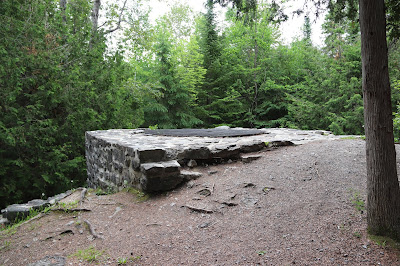The Flood lime kiln is one of the few remaining examples of a 19th-century industrial lime kiln in Canada. Lime was an important building and household chemical used to make mortar, fertilizer, whitewash, plaster and many other products. Francis Flood built this kiln in the late 1800s on a miniature escarpment of exposed limestone bedrock known as the Hazeldean Fault. Most lime producers went out of business in the early 1900s as new and larger industrial kilns were constructed and Portland cement was introduced from Europe. The Flood kiln ceased operation around 1906, and the site was abandoned and fell into disrepair. The ruins of the kiln were rediscovered and its significance realized in the early 1970s. The site was restored in 1999.
National Capital Commission, Canada
Le four à chaux de Flood et l'un des quelques exemples qui restent d'un four à chaux industriel du XIXe siècle au Canada. La chaux constituait un produit chimique important, utilisé pour la construction et les travaux ménagers. On ne faisait du mortier, de l'engrais, du lait de chaux, du plâtre et de nombreux autres produis. Francis Flood a érigé ce four à la fin des années 1800 sur un petit escarpment de roche calcaire de fond exposée, appelé « faille Hazeldean ». La majorité des producteurs de chaux ont mis fin à leurs opérations au tout début du XXe siècle, au fur et à mesure de l'introduction de fours plus gros et plus modernes et quant est arrivé le ciment Portland, en provenance d'Europe. Le four à chaux de Flood a cessé de fonctionner autour de 1906. Le lieu a été abandonné et s'est délabré. Les ruines du four ont été redécouvertes et on s'est rendu compte de leur importance au début des années 1970. Le site a été restauré en 1999.
Commission de la capitale nationale, Canada
The Flood lime kiln was comprised of five outbuildings surrounding the circular kiln post includint the limehouse where the finished lime was stored and the powder magazien where the black powder used for quarrying was kept.
The kiln was known as a "pot" or intermittent kiln; wood and limestone quarried from the nearby escarpment were placed into the circular pot and fired for several days. The resulting ash and lime were removed from the opening at the bottom of the kiln and stored in a building attached to the kiln.
The lime produced at this kiln was sold to local industries and farmers.
Settlers used the lime to make mortar for "chinking" log houses and grouting stone houses.
Le four à chaux de Flood comprenait cinq bâtiments extérieurs disposés en rond autour du four circulaire. On y trouvait entre autres, l'entrepôt où l'on gardait la chaux terminée ainsi que la poudrière où l'on conservait la poudre noire, utilisée pour l'extraction en carrière.
La four était appelé « pot » (ou four intermittent). On plaçait, dans le pot circulaire; du bois et de la pierre calcaire extraite de l'escarpment voisin. On faisait fonctionner le four pendant plusieurs jours. La centre et la chaux qui en résultaient étaient retirés de l'ouverture au fond du four et entreposées dand un bâtiment annexé au four.
La chaux produite à ce four était vendue aux industries et aux fermiers locaux.
Les pionners utilisaient la chaux pour « colmater » les maisons de rondins et comme mortier pour les maisons de pierre.
 |
| Powder Magazine • Poudrière |
 |
| Limehouse • Entrepôt |
 |
| Kiln • Four |
 |
| Quarry • Carrière |
 |
| This is the same plaque that's at the beginning of the trail. |






















































